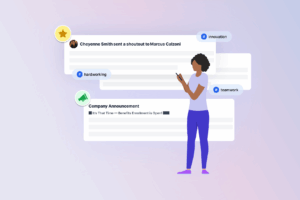Share
KEY TAKEAWAYS:
- HR professionals are faced with numerous challenges, ultimately limiting their influence at the highest levels of leadership
- Truly successful HR departments are able to elevate their goals and initiatives to help businesses grow and succeed
- By advocating for efficient processes, universally beneficial policies, and employee well-being, HR can lead the way towards greater company-wide performance and success
HR departments handle a lot more than payroll and pink slips. In companies where HR has real influence, bold HR initiatives can improve the whole company and culture for long-term growth. Once you recognize the challenges that must be overcome, it’s easy to see several ways that HR can lead the way towards greater company-wide performance and success.
Be Aware of the Challenges to HR Growth
Unfortunately, many HR departments never get the chance to live up to their full potential. Without efficient software, essential HR paperwork can become a full-time job in itself. Challenging circumstances and company hierarchies also limit the influence of HR, but things are beginning to change.
HR typically viewed as “support” rather than leadership
Roles like CHRO and Chief People Officer (CPO) show a changing attitude about HR growth and leadership. Even smaller HR departments need to cultivate a relationship with company leadership.
Handling complaints and answering questions are important functions of HR, but reacting to problems isn’t the same as steering the company culture in a positive direction.
Recruiting and retention struggles
In 2023, it took an average of 47.5 days to fill a job opening, according to a Recruiter Nation survey cited by SHRM.
Even in a favorable job market, HR staff need to put a lot of time and energy into the hiring process. If your company is always struggling with excessive turnover, then you may have some underlying problems with compensation or working conditions.
Budget concerns
Ambitious proposals from HR tend to look expensive to CEOs who focus on the short term costs. Even a “free” training program takes time away from productivity. Budget-conscious HR staff should be sure to explain the potential payoff, like how improved retention will reduce turnover costs.
Constantly evolving environment
Between RTO mandates and evolving AI resources, workplace norms are changing faster than ever. New legislation and regulations create challenges for staying compliant. HR can take a leadership role by being more proactive instead of reacting to outside changes at the last minute.
10 Ways HR Can Improve Your Organization’s Performance & Growth
Empowered to do more than the routine paperwork, HR staff can inspire and motivate the whole workforce. There doesn’t need to be a conflict between advocating for employee well-being and policies that ultimately benefit the company.
Promote a healthy work-life balance
A study by Randstad found that half of workers are more interested in “balance and belonging” than advancing in their personal careers.
Flexible scheduling, vacation days, parental leave, remote work, and other popular perks improve the employee experience. Shifting the culture of your workplace in a positive direction will improve employee satisfaction and (ultimately) productivity.
Encourage innovation and creativity
Employees want to feel like their voices are heard. Far from focusing exclusively on workers from minority demographics, year-round DEI initiatives encourage everyone to bring creative and innovative ideas to the table. Give public kudos to workers who make helpful proposals, and their colleagues will be emboldened to bring new ideas to the table.
Increase productivity
HR can also help align and optimize workflows and processes. Encourage workers to identify communication barriers and bottlenecks that cause frustration. Scalability is key for a growing business, but it’s also essential for sustainable HR growth initiatives.
Provide constructive and informed feedback
360 reviews capture different perspectives on problems, keeping managers accountable. Use balanced feedback and objective data for employee reviews. Some employee complaints will be personally subjective, but HR policies should provide a foundation for fair and constructive resolution.
Foster a culture of safety and security
Training and check-ins allow HR staff to improve a toxic workplace culture. Employees need to feel physically and emotionally safe at work, even when they don’t get along with all their colleagues.
In tense election years, clear boundaries and social media policies reduce the danger of political arguments spiraling out of control.
Focus on career development
Each employee has their own goals, priorities, and needs. Performance management strategies like 9-box reporting help workers improve their personal productivity. Optional training programs allow employees to grow professionally in their current roles.
Ensure company-wide communication
Frequent anonymous surveys promote a culture of employee feedback. Make sure you share the results of surveys and take meaningful action in response to constructive feedback. When you demonstrate that your company values employees and their input, they’ll be more personally invested in their jobs and performance.
Align goals and objectives
As one of the few positions with company-wide influence, HR leadership has the power to help different departments work toward the same goals. To get more buy-in with leadership and individual managers, HR growth objectives should tie back to shared goals of the business.
One study found that each increase in employee happiness (rated on a 10-point scale) resulted in 12% more productivity (specifically in sales).
Support mergers and acquisitions
Mergers and acquisitions are powerful tools for growth and expansion, playing a far bigger role in the American economy than other countries. Many mergers include a consolidation to remove redundancy, which might make entire departments of one company obsolete.
Change management strategies allow HR staff to reduce anxiety and uncertainty in the workforce, smoothing out the transition process and providing transparency where appropriate.
Hiring and retaining the best talent
Successful companies need to find (and keep) people that help them grow. Strategic Workforce Planning looks ahead to the future goals of the business, not just today’s vacancies. Actionable HR reporting goes beyond the basics to tackle bigger issues like recruiting, engagement, and turnover.
Discover how Netchex can help your elevate your HR department:
Related articles

Introducing HR Reporting with AI that Can Actually Impact Your Bottom Line

The Real ROI of Streamlining HR and Payroll

Tasks & Workflows: Innovating Automation for HR

